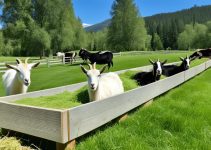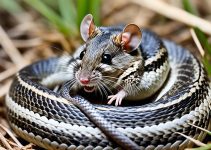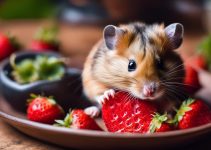Hello, fellow guinea pig enthusiasts! Today, I want to address a burning question on every guinea pig owner’s mind—are guinea pigs able to eat watercress? Well, you’re in luck! Watercress happens to be a safe and nutritious vegetable that your furry friend can enjoy to their heart’s content.
As herbivores, guinea pigs thrive on a diet that consists of hay, leafy greens, and vegetables. Watercress, with its low-calorie content, proves to be an excellent addition to their meal plan. This delightful vegetable is not only packed with essential nutrients such as vitamin C, vitamin K, and potassium, but it also boasts antioxidants that contribute to your pet’s overall well-being.
However, like with any food, moderation is key. Feeding excessive amounts of watercress can lead to digestive issues, and keep in mind that guinea pigs prone to bladder stones may need to avoid this leafy green. Additionally, remember to thoroughly wash watercress before offering it to your precious pet to get rid of any pesticide residue.
Before making any significant changes to your guinea pig’s diet, it is essential to consult with a veterinarian. They will provide expert advice tailored to your pet’s specific needs and ensure their health and happiness.
Can Guinea Pigs Eat Watercress? Yes, they can.
- Watercress is safe and nutritious for guinea pigs when fed in moderation.
- It is packed with essential nutrients like vitamin C, vitamin K, and potassium.
- Watercress should be washed thoroughly before feeding it to your pet to remove any harmful pesticides.
- Consult with a veterinarian before introducing any new food into your guinea pig’s diet.
- Moderation is key to prevent digestive issues and potential risks for guinea pigs prone to bladder stones.
Nutritional Benefits of Watercress for Guinea Pigs
Watercress is a leafy green vegetable that offers a multitude of nutritional benefits for guinea pigs. This vibrant green veggie boasts an impressive array of vitamins and minerals, making it an excellent addition to your furry friend’s diet.
Vitamin C: Watercress is a rich source of vitamin C, an essential nutrient for guinea pigs. Vitamin C plays a crucial role in supporting their immune system, aiding in cell growth and repair, and promoting wound healing. Including watercress in your guinea pig’s diet can help ensure they receive this vital vitamin.
Vitamin K: Another notable nutrient found in watercress is vitamin K. This vitamin is essential for blood clotting, helping to prevent excessive bleeding and support healthy circulation in guinea pigs.
Potassium: Watercress contains significant amounts of potassium, a mineral that helps regulate fluid levels in the body. Ensuring an adequate intake of potassium is beneficial for maintaining proper hydration and overall health in guinea pigs.
Calcium: Calcium is vital for guinea pigs, as it supports healthy bone development and contributes to proper muscle function. Watercress provides a good amount of calcium, ensuring your furry companion receives the necessary nutrients for strong bones and muscles.
By incorporating watercress into your guinea pig’s diet, you can help them reap the incredible nutritional benefits it offers. Just remember to introduce new foods gradually and consult with a veterinarian to ensure it suits your guinea pig’s specific dietary needs.
Risks of Feeding Watercress to Guinea Pigs
While watercress is generally safe for guinea pigs, it’s important to be aware of the potential risks involved. Feeding too much watercress can cause digestive problems such as bloating and diarrhea. This is because watercress is high in fiber, which can be difficult for guinea pigs to digest in large amounts. It’s best to introduce watercress gradually into their diet to avoid any digestive issues.
Another risk to consider is the potential for bladder stones. Watercress is high in calcium, and guinea pigs prone to bladder stones should avoid excessive consumption of watercress. The high calcium content in watercress can contribute to the formation of these stones, which can be quite painful and require medical intervention.
Additionally, pesticides are a concern when feeding watercress to guinea pigs. Like any vegetable, watercress may be treated with pesticides during the growing process. It is crucial to wash the watercress thoroughly before serving it to your furry friend, ensuring that all traces of pesticides are removed. This helps minimize the risk of exposing your guinea pig to harmful chemicals.
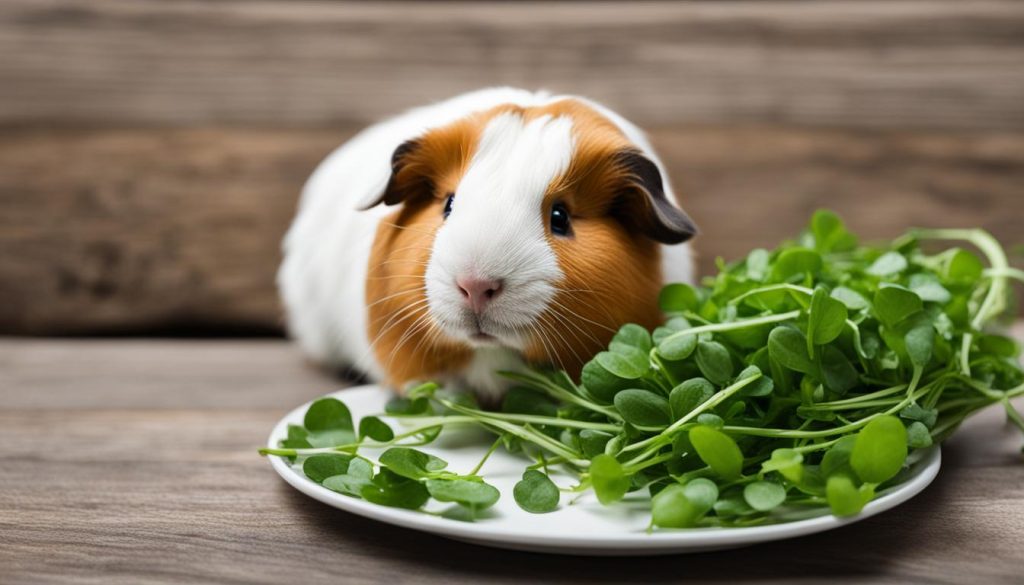
Adding Watercress to Your Guinea Pig’s Diet
When considering adding watercress to your guinea pig’s diet, it’s important to first consult with a veterinarian to ensure it is safe and appropriate for your furry friend. Guinea pigs have sensitive digestive systems, so introducing new foods should be done gradually to avoid any stomach upsets.
Start by offering small quantities of watercress and closely monitor your guinea pig’s response. If there are no adverse effects, you can gradually increase the portion size. Remember to wash the watercress thoroughly, removing any wilted or yellow leaves, as they can be bitter and unappetizing for your pet.
Watercress can be given a couple of times a week as part of their meal or as a special treat. However, it’s crucial to practice portion control to prevent any digestive issues. Overfeeding watercress can lead to bloating and diarrhea in guinea pigs, so it’s important to strike the right balance.
Adding watercress to your guinea pig’s diet can provide them with additional variety and essential nutrients. Just remember to take it slow, wash it thoroughly, and be mindful of portion sizes to keep your guinea pig happy and healthy.
The Importance of a Balanced Diet for Guinea Pigs
While watercress is a valuable addition to a guinea pig’s diet, it should not be the sole focus. Guinea pigs require a balanced diet that consists of various components to meet their nutritional needs for optimal health.
A healthy diet for guinea pigs should include:
1. Hay:
Hay, such as timothy or grass hay, is an essential component of a guinea pig’s diet. It provides the necessary fiber for maintaining dental health and gastrointestinal function. Guinea pigs should have access to fresh hay at all times.
2. Fresh greens:
In addition to watercress, guinea pigs can enjoy a variety of leafy greens that are safe for them to consume. Some examples include romaine lettuce, parsley, and dandelion greens. These leafy greens provide additional nutrients and help to promote a healthy digestive system.
3. Vegetables:
Alongside leafy greens, guinea pigs can benefit from a variety of vegetables, such as bell peppers, carrots, and cucumbers. These vegetables provide additional vitamins and minerals to support their overall health.
4. Pellets:
Pellets specifically formulated for guinea pigs can help ensure they receive adequate nutrition. These pellets are designed to provide a balanced mix of vitamins, minerals, and other essential nutrients for guinea pig health. However, it’s important to follow guinea pig food guidelines and feed pellets in moderation, as an excessive amount can lead to obesity and other health issues.
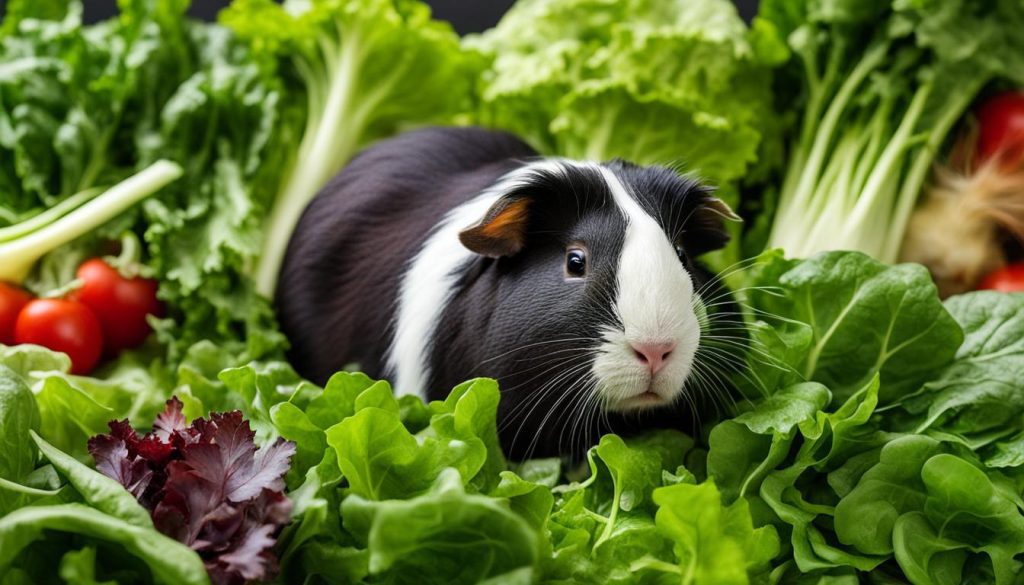
It is important to note that guinea pigs have specific dietary requirements, and not all foods are safe for them to consume. Be mindful of foods that are toxic to guinea pigs, such as chocolate, onions, and certain fruits and vegetables.
Consulting with a veterinarian is essential to ensure a healthy and balanced diet for your guinea pig. They can provide guidance on portion sizes, frequency of feeding, and any specific dietary needs your pet may have.
By providing a balanced diet that includes hay, fresh greens, vegetables, and appropriate pellets, you can ensure that your guinea pig receives all the necessary nutrients for a happy and healthy life.
Proper Care and Housing for Guinea Pigs
Guinea pigs require proper care and housing to thrive. As a responsible owner, it is important to ensure they have a comfortable and enriching environment. Let’s discuss some key aspects of guinea pig care and housing:
Housing for Guinea Pigs
Guinea pigs should be housed in spacious cages that allow them to move around comfortably. A cage should provide enough room for your guinea pig to exercise, play, and relax.
Guinea Pig Enclosure
The enclosure should include hiding spots where your guinea pig can retreat when it wants to feel safe. Adding items like cardboard boxes, tunnels, and chew toys can provide enrichment and mental stimulation for your furry friend.
Guinea Pig Enrichment
Enrichment is an essential part of keeping your guinea pig happy. It keeps them mentally stimulated and prevents boredom. You can introduce new toys, rotate their hiding spots, or create obstacle courses to keep things interesting for them.
Exercise for Guinea Pigs
Exercise is crucial for maintaining the health and well-being of your guinea pig. They should have daily supervised exercise outside their cage to promote physical activity. You can designate a safe area in your home or use a guinea pig playpen for this purpose.
Remember, guinea pigs are active animals and need opportunities to stretch their legs and explore their surroundings. Just make sure to create a secure and controlled environment to prevent any accidents or escapes.
Handling and Socialization of Guinea Pigs
Guinea pigs are social animals and thrive on human interaction and the companionship of other guinea pigs. When handling a guinea pig, it’s important to do so with care and gentleness, supporting their body with both hands to ensure their safety and comfort.
While some guinea pigs may initially try to escape when being handled, it is rare for them to display aggression. Patience and a calm approach will help build trust between you and your guinea pig.
To provide a safe and comfortable space for interaction, it is recommended to play with and interact with your guinea pigs on the floor. This allows them to explore and move around freely while still being close to you.
Guinea pigs can also be housed together, but it is important to provide adequate cage space to prevent territorial behavior. Neutering may be necessary to ensure a harmonious living environment, especially if you plan on housing males together.
Socializing and bonding with your guinea pigs is a rewarding experience that helps establish a strong and trusting relationship. Spending quality time with them, such as gentle petting and talking to them softly, can strengthen the bond you share.
Conclusion
Watercress can be a valuable addition to a guinea pig’s diet. Its nutrient-rich profile, including vitamin C, vitamin K, and potassium, makes it a beneficial leafy green to incorporate into their meals. However, it is important to feed watercress in moderation to prevent digestive issues and be cautious if your guinea pig is prone to bladder stones. Consultation with a veterinarian is essential before introducing any dietary changes for your furry friend.
Remember that a balanced diet is crucial for the overall health and well-being of guinea pigs. Alongside watercress, provide a variety of hay, fresh greens, vegetables, and pellets to ensure they receive the necessary nutrients. Hay, such as timothy or grass hay, promotes dental health and gastrointestinal function. Fresh greens like watercress should be offered in conjunction with other safe options like romaine lettuce, parsley, and dandelion greens. Pellets formulated specifically for guinea pigs can help meet their nutritional requirements. Always follow guinea pig food guidelines and consult with a veterinarian to ensure the best diet for your adorable pet.
By prioritizing a balanced diet and consulting with a veterinarian, you can keep your guinea pig happy, healthy, and thriving. Remember to monitor their response to watercress and adjust the portion sizes accordingly. With proper care, attention, and a nutritious diet, your guinea pig will be a vital member of your family for many years to come.
FAQ
Can guinea pigs eat watercress?
Yes, guinea pigs can eat watercress. It is a safe and nutritious vegetable for them.
What are the benefits of watercress for guinea pigs?
Watercress is rich in nutrients like vitamin C, vitamin K, and potassium, which are essential for a guinea pig’s health.
Are there any risks in feeding watercress to guinea pigs?
Feeding too much watercress can cause digestive problems, and it may not be suitable for guinea pigs prone to bladder stones. Thoroughly wash the watercress to remove any pesticides.
How should I add watercress to my guinea pig’s diet?
Consult with a veterinarian before adding watercress to your guinea pig’s diet. Start with small quantities and monitor your guinea pig’s response. Wash the watercress thoroughly and introduce it gradually.
What should be included in a balanced diet for guinea pigs?
A balanced diet for guinea pigs includes hay, fresh greens, vegetables, and pellets formulated specifically for guinea pigs.
How should I care for and house my guinea pig?
Guinea pigs should be housed in spacious cages with hiding spots, enrichment items, and non-slip flooring. Provide fresh timothy hay, water, and supervised daily exercise outside the cage.
How should I handle and socialize my guinea pig?
Handle guinea pigs with care, support their body with both hands, and interact with them on the floor. Guinea pigs are social animals and can be housed together with proper space and consideration.
What is the conclusion for feeding watercress to guinea pigs?
Watercress can be a beneficial addition to a guinea pig’s diet, but it should not be the sole focus. Consult with a veterinarian for a healthy and balanced diet for your guinea pig.

